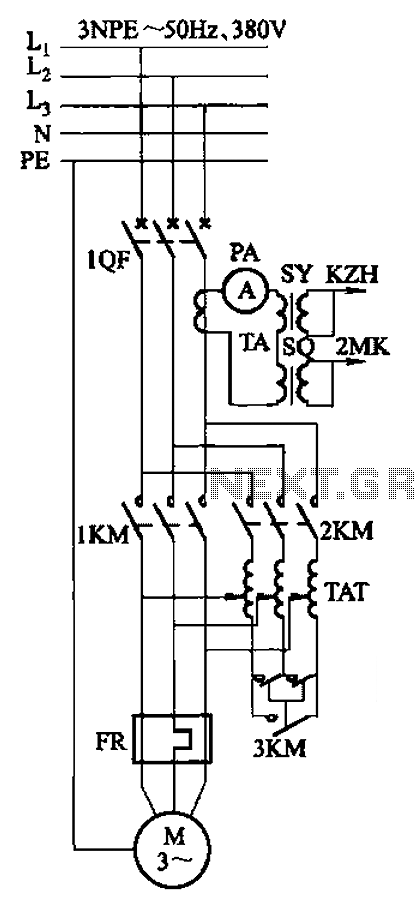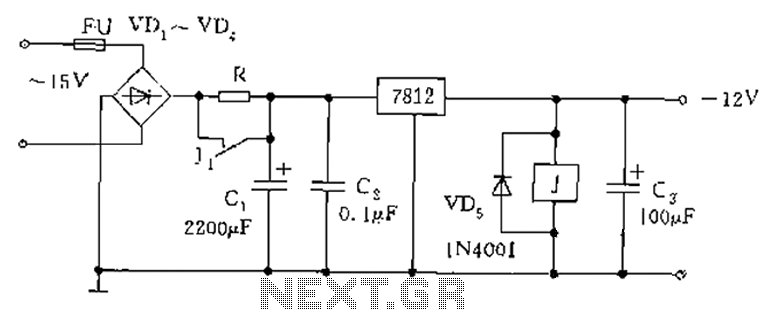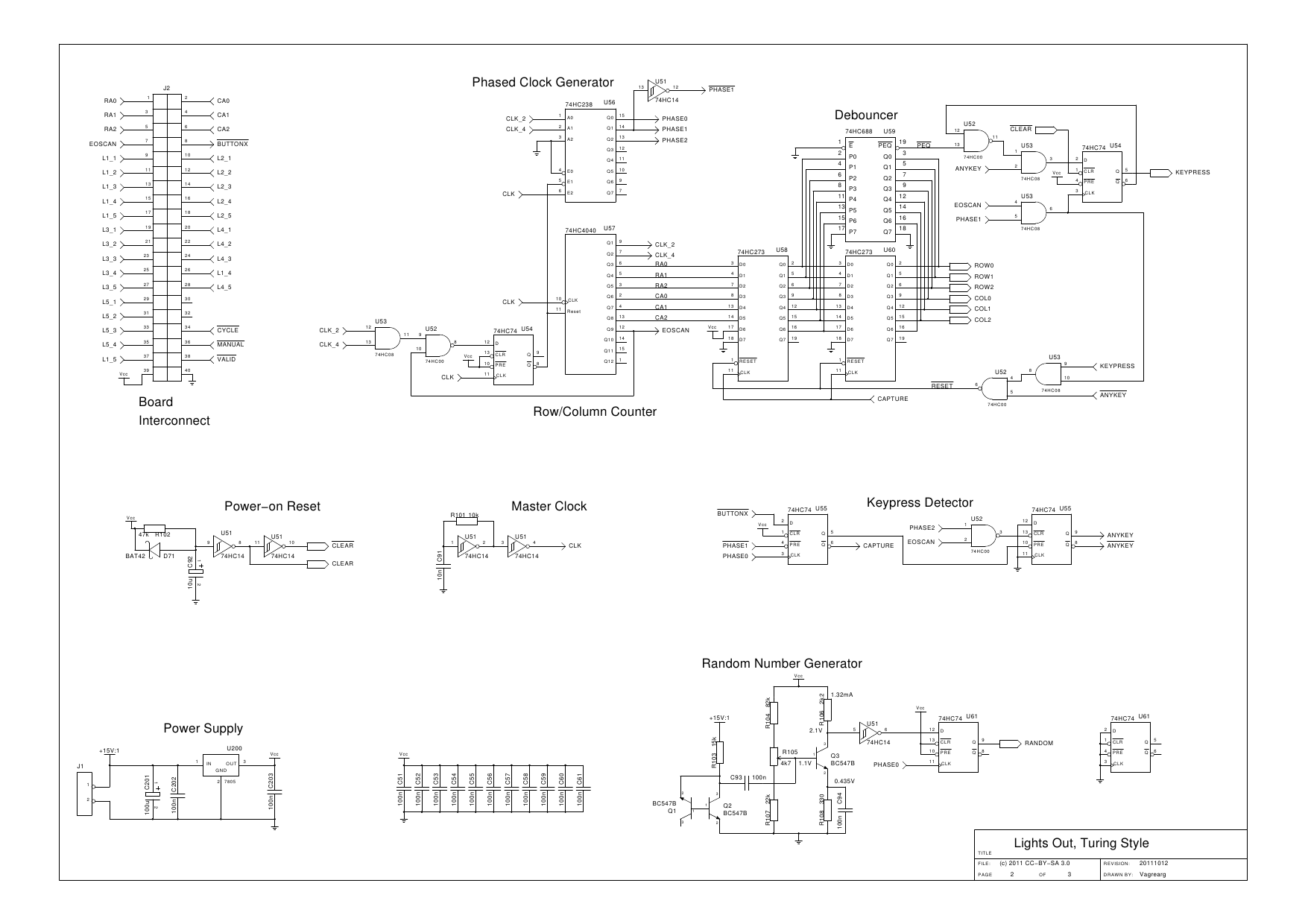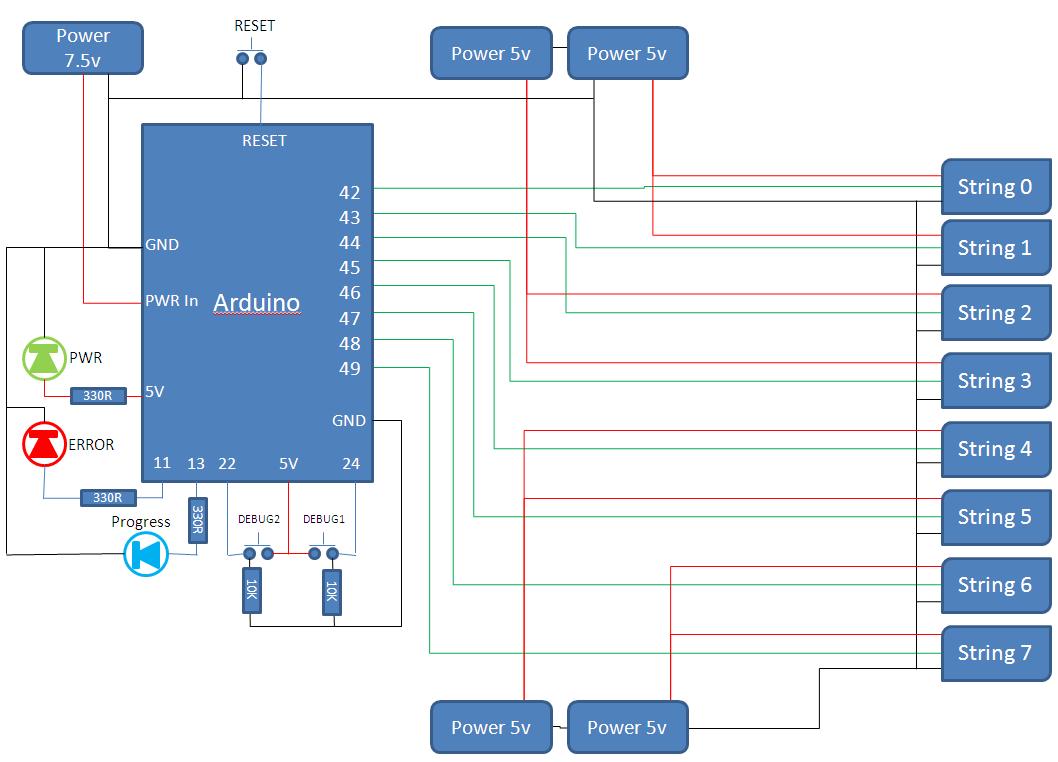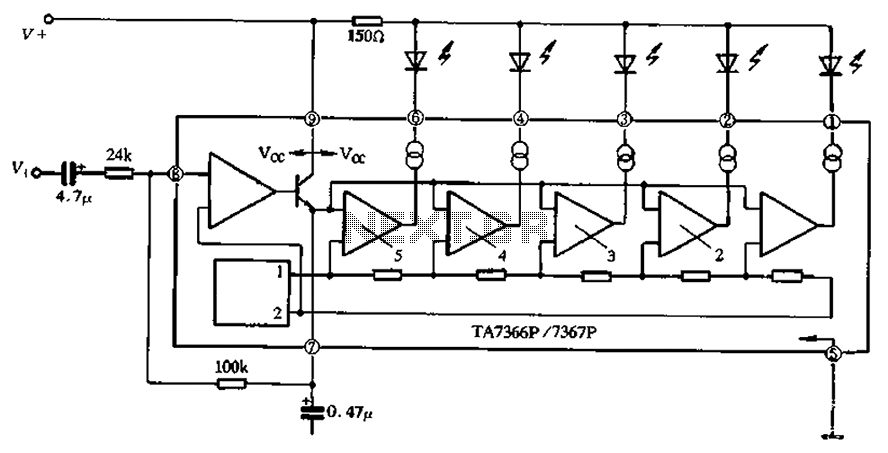
Grand Prix Starting Lights
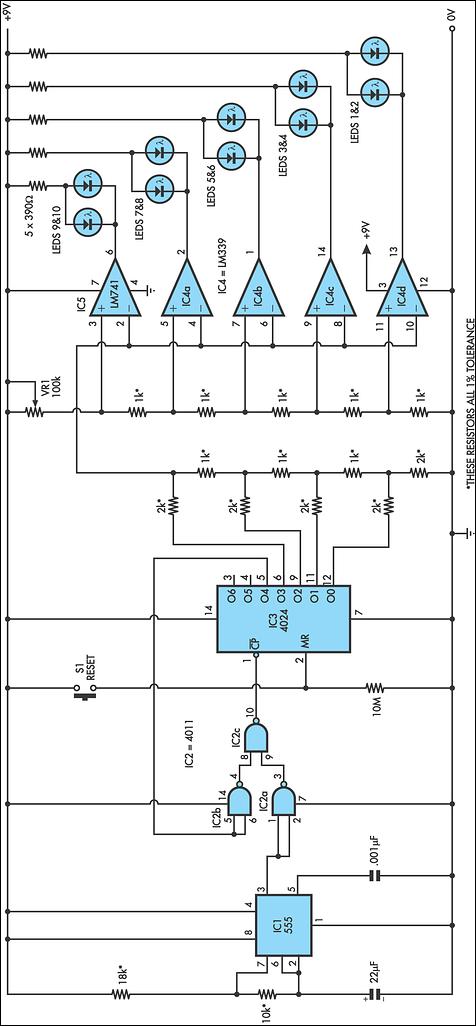
This circuit replicates the starting light sequence used by FISA in Formula One racing. It can be utilized with slot car sets (such as HO scale AFX, Life Like, or Tyco sets) or radio-controlled cars. The circuit employs a 555 timer integrated circuit (IC1) as a clock pulse generator. The output from IC1 is routed through NAND gates (IC2a and IC2c) to a 4024 binary counter (IC3). The output O4 of the 4024 binary counter is inverted by IC2b. Initially, IC3 is reset, and all its outputs are low, including O4, which causes IC2b to present a logical high to the pin 8 input of IC2c, allowing clock pulses from the 555 timer to reach the clock input of the 4024. IC3 then begins counting. When the count reaches binary 1111, the next pulse sets the O4 output of IC3 high, which disables IC2c, halting the counting process. The four active outputs of IC3 are connected to a resistor ladder that functions as a simple digital-to-analog converter (DAC). As the count increases, the voltage produced at the top of the ladder also increases, connecting to the inverting inputs of four comparators within IC4 (an LM339) and to IC5, a 741 operational amplifier configured as a comparator. The positive inputs of the comparators are linked to the taps of a voltage divider, with the tap voltages adjusted using VR1, a 100kΩ trimpot. As IC3 counts, the rising stepped voltage from the DAC ladder sequentially activates the comparators, starting with IC4d and progressing to IC5. Each comparator activation lights a pair of LEDs; first, LEDs 1 and 2 are illuminated, followed by LEDs 3 and 4, and so forth. Once all five pairs of LEDs are lit, the subsequent pulse from IC1 advances the binary count of IC3 to 10000, causing the DAC voltage to drop to zero and extinguishing all LEDs. Simultaneously, counting ceases because the high signal on O4 prevents further gate pulses from IC2c. The circuit remains inactive until it is reset by pressing pushbutton switch S1, enabling the initiation of a new sequence.
This circuit design effectively simulates the starting light sequence used in professional racing, allowing for a visually engaging experience in model racing setups. The 555 timer serves as a reliable clock source, generating consistent pulses that drive the counting mechanism. The 4024 binary counter provides a straightforward means of counting, while the use of NAND gates ensures proper control over the counting process.
The digital-to-analog converter (DAC) implemented via the resistor ladder is a critical component, as it translates the binary count into a corresponding voltage level. This voltage is then compared against predetermined reference levels set by the voltage divider, allowing for the sequential activation of the LEDs. The choice of comparators, including the LM339 and the 741 op-amp, provides flexibility in signal processing and ensures accurate switching of the LED indicators.
The inclusion of a reset mechanism via the pushbutton switch (S1) allows for easy reinitialization of the circuit, facilitating repeated sequences without the need for manual intervention in reconfiguring the circuit. This feature enhances the usability of the circuit in various applications, including hobbyist projects and educational demonstrations in electronics. Overall, the design is efficient, straightforward, and serves as an excellent example of integrating various components to achieve a specific functional outcome in electronic circuits.This circuit reproduces the starting light sequence currently used by FISA for Formula One racing. It could be used with slot car sets (such as HO scale AFX/Life Like/Tyco sets) or radio controlled cars. IC1, a 555 timer IC, is used as a clock pulse generator. Its output is fed via NAND gates IC2a and IC2c to IC3, a 4024 binary counter. IC2b inver ts the O4 output of 4024 binary counter IC3. Initially, IC3 is reset and all its outputs are low, including O4, which causes IC2b to present a logical high to the pin 8 input of IC2c which then passes pulses from the 555 clock circuit to the clock input of the 4024. IC3 then begins counting. After the count has reached binary 1111, the next pulse sends the O4 output of IC3 high, which disables IC2c and IC3 stops counting.
The four used outputs of IC3 are connected to a resistor `ladder` which acts as a simple digital to analog convert-er (DAC). As the count increases so does the voltage produced at the top of the ladder and this is connected to the inverting inputs of four comparators inside IC4 (an LM339) and to IC5, which is a 741 op amp also connected as a comparator.
The positive inputs of the comparators are connected to the taps of a voltage divider, with the tapping voltages set using VR1, a 100kO trimpot. As IC3 counts, the rising stepped voltage from the DAC ladder switches the comparators on in sequence, starting with IC4d and working up to IC5.
As each comparator is turned on, its pair of LEDs is lit; first LEDs 1 & 2, then LEDs 3 & 4 and so on. When all five pairs of LEDs are lit, the next pulse from IC1 moves the binary count of IC3 to 10000, so the DAC voltage drops back to zero and all LEDs are extinguished.
At the same time, counting also stops, because the high on O4 causes IC2c to block further gate pulses. The circuit then remains inactive until the counter is reset by pressing pushbutton switch S1. This allows a new sequence to begin. 🔗 External reference
This circuit design effectively simulates the starting light sequence used in professional racing, allowing for a visually engaging experience in model racing setups. The 555 timer serves as a reliable clock source, generating consistent pulses that drive the counting mechanism. The 4024 binary counter provides a straightforward means of counting, while the use of NAND gates ensures proper control over the counting process.
The digital-to-analog converter (DAC) implemented via the resistor ladder is a critical component, as it translates the binary count into a corresponding voltage level. This voltage is then compared against predetermined reference levels set by the voltage divider, allowing for the sequential activation of the LEDs. The choice of comparators, including the LM339 and the 741 op-amp, provides flexibility in signal processing and ensures accurate switching of the LED indicators.
The inclusion of a reset mechanism via the pushbutton switch (S1) allows for easy reinitialization of the circuit, facilitating repeated sequences without the need for manual intervention in reconfiguring the circuit. This feature enhances the usability of the circuit in various applications, including hobbyist projects and educational demonstrations in electronics. Overall, the design is efficient, straightforward, and serves as an excellent example of integrating various components to achieve a specific functional outcome in electronic circuits.This circuit reproduces the starting light sequence currently used by FISA for Formula One racing. It could be used with slot car sets (such as HO scale AFX/Life Like/Tyco sets) or radio controlled cars. IC1, a 555 timer IC, is used as a clock pulse generator. Its output is fed via NAND gates IC2a and IC2c to IC3, a 4024 binary counter. IC2b inver ts the O4 output of 4024 binary counter IC3. Initially, IC3 is reset and all its outputs are low, including O4, which causes IC2b to present a logical high to the pin 8 input of IC2c which then passes pulses from the 555 clock circuit to the clock input of the 4024. IC3 then begins counting. After the count has reached binary 1111, the next pulse sends the O4 output of IC3 high, which disables IC2c and IC3 stops counting.
The four used outputs of IC3 are connected to a resistor `ladder` which acts as a simple digital to analog convert-er (DAC). As the count increases so does the voltage produced at the top of the ladder and this is connected to the inverting inputs of four comparators inside IC4 (an LM339) and to IC5, which is a 741 op amp also connected as a comparator.
The positive inputs of the comparators are connected to the taps of a voltage divider, with the tapping voltages set using VR1, a 100kO trimpot. As IC3 counts, the rising stepped voltage from the DAC ladder switches the comparators on in sequence, starting with IC4d and working up to IC5.
As each comparator is turned on, its pair of LEDs is lit; first LEDs 1 & 2, then LEDs 3 & 4 and so on. When all five pairs of LEDs are lit, the next pulse from IC1 moves the binary count of IC3 to 10000, so the DAC voltage drops back to zero and all LEDs are extinguished.
At the same time, counting also stops, because the high on O4 causes IC2c to block further gate pulses. The circuit then remains inactive until the counter is reset by pressing pushbutton switch S1. This allows a new sequence to begin. 🔗 External reference
